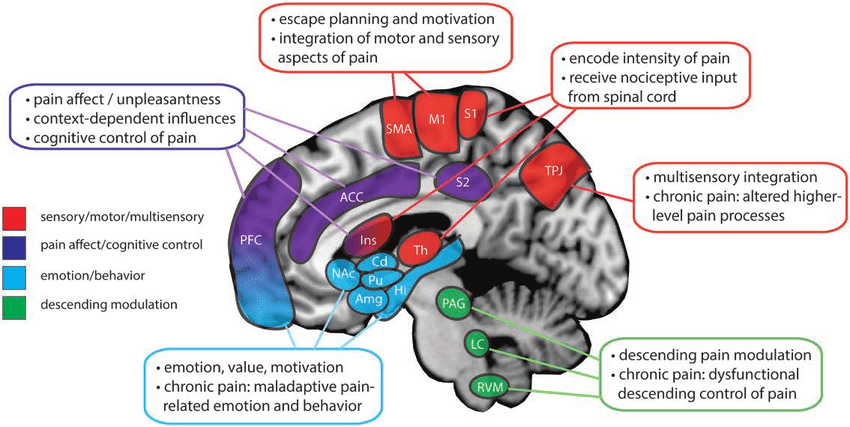Pain in the Brain!
How does pain work?
According to the CDC, about 21% of adults are experiencing chronic pain in the US. As a provider who works in the space of changing chronic pain, understanding HOW pain works is KEY to living a limitless life!
Pain is not just the result of a stimulus or injury. It is routed, processed, and filtered through various parts of our brain in attempt to interpret the signals. Which means there are a lot of influences that can change what I like to call the "dials" of pain intensity.
Make it stand out
The pain route
Painful stimuli often travels from the excitation of a pain receptor in an area of the body >> through a peripheral nerve >> through the particular column in the spinal cord >> and up to the brain.
But when it's in the brain, it goes all kinds of places!
The somatosensory cortex to interpret both motor and sensory components of pain.
The prefrontal cortex and anterior cingulate gyrus for cognitive processing and decisions about the pain based on context.
The limbic system where emotions and memories are processed.
Various parts of the brainstem where pain can be inhibited or controlled.
What does this mean?
All this really means is that many things including our memories, fears, emotions, self preservation, perception of safety, and belief about the situation or cause of pain ALL influence the intensity and experience of painful sensations.
So how do we change pain intensity on our own and turn down the dials at each part?
You can calm these areas of your brain!
1. How to turn down the dial of the Prefrontal Cortex
> Beliefs!
Do some checks to help your brain understand the severity:
Can it change with movement? = mechanical in nature, likely not life threatening if not from a trauma.
Does it reduce with deep breaths? = this calms the nervous system, not emergent.
Does pain increase with stress? = the dials are high! and thus likely elevated compared to the stimulus.
2. How to turn down the dial of the Limbic System
> Identify Fears!
Anxiety about how this might affect our future turns up the dial!
Consider the possibility of being pain free just as high as pain persisting!
3. How to turn down the dial at the Brain Stem
We can create descending inhibition to calm the nervous system
Mindfulness practices can help shift the amplitude of signals.
4. How to change the dial of the Somatosensory Cortex
Alter sensations from and to our peripheral nerves
Isometric contractions: this changes sensory input.
Global movement: move as many parts of your body like walking, dance, etc. This cause analgesia in our nervous system especially if done for 20 consecutive minutes.
Oscillating movements: such as rocking, pacing - reduces the overflow of electricity in nerves
Diaphragm breathing: actives the parasympathetic nervous system to calm sensations, tension, cortisol levels.
We love helping people learn more about persistent pain and how to change it! Give these strategies a try, share them with your friends, and also let us help! Often, we need guidance to get out of pain loops given how complex pain is. We'd love to be that guidance for you!


